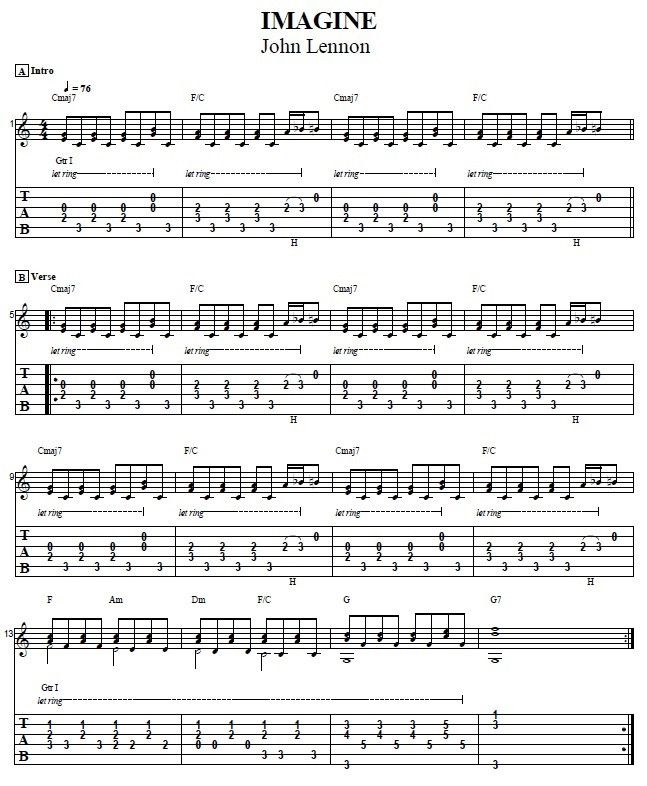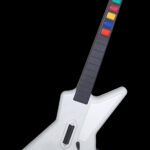“Imagine” by John Lennon is a timeless classic, originally composed on piano. But did you know it sounds just as beautiful on guitar? In this lesson, Darrin Goodman from GuitarControl.com will guide you through a simple yet captivating fingerstyle guitar arrangement of this iconic song. Perfect for acoustic or electric guitar, this arrangement is fairly easy to learn and incredibly rewarding to play.
 John Lennon Imagine Guitar Chords Lesson on GuitarControl.com
John Lennon Imagine Guitar Chords Lesson on GuitarControl.com
Let’s dive into the chords and techniques you’ll need to bring “Imagine” to life on your guitar.
Mastering the Core Chords: Cmaj7 and F/C
The intro and verse riff of “Imagine” are built around two fundamental chords: C major 7 (Cmaj7) and F over C (F/C).
-
C Major 7 (Cmaj7): If you already know the basic C chord, Cmaj7 is an easy modification. Simply remove your first finger from the standard C shape. This voicing is played as follows:
- 3rd finger: 3rd fret of the 5th string
- 2nd finger: 2nd fret of the 4th string
- Remaining strings: Open
-
F over C (F/C): This chord uses a familiar F major shape but with a C note in the bass, creating a rich and full sound. To play F/C:
- 1st finger: Barre across the 1st and 2nd frets of the 1st and 2nd strings
- 3rd finger: 2nd fret of the 3rd string
- 4th finger: 3rd fret of the 4th string
- 3rd finger (again): 3rd fret of the 5th string
These two chords form the foundation of the intro and the verse riff, making them essential to learn first.
Fingerpicking the Intro and Verse Riff
Now, let’s explore the fingerpicking pattern that brings these chords to life. For both Cmaj7 and F/C, the pattern starts the same:
- Thumb: Pluck the 5th string (the bass note).
- 1st and 2nd Fingers: Simultaneously pluck the 4th and 3rd strings.
Repeat this sequence three times. This creates a gentle and rhythmic foundation for the melody.
After the three repetitions, the pattern slightly changes:
- 2nd Finger: Pluck the 3rd string.
- 3rd Finger: Pluck the 2nd string.
Finally, return to the bass note:
- Thumb: Pluck the 5th string again.
This completes the first measure of the riff over Cmaj7.
For the second measure, switch to the F/C chord and repeat the initial strumming pattern (thumb on 5th, fingers 1 & 2 on 4th and 3rd strings) three times.
Then, for a touch of dissonance that adds character to the arrangement:
- 2nd Finger: Pluck the 2nd fret of the 3rd string.
- Hammer-on: Use your 3rd finger to hammer-on to the 3rd fret of the 3rd string.
- Open 2nd String: Play the open 2nd string.
This slightly dissonant lick adds a unique flavor to the “Imagine” guitar chords arrangement. This two-measure sequence, alternating between Cmaj7 and F/C, is repeated twice for the intro and four times during the verse, forming the core of the song’s harmonic and rhythmic structure.
Moving Through the Verse Chords
As the song progresses beyond the intro, you’ll encounter a few more chords. After the F/C, the song moves to a simple F major chord. You can use the same F shape you used for F/C, but simply remove your 4th finger. Alternatively, you can play a standard F barre chord.
Next, you’ll encounter A minor (Am). If you’re transitioning from F, your first finger is already in a good position. Simply roll your first finger up slightly to fret the 1st fret of the 2nd string (without barring), and add your 2nd and 3rd fingers to the 2nd fret of the 4th and 3rd strings respectively.
Following Am is D minor (Dm). From the Am chord, adjust your fingers as follows:
- Move your 1st finger to the 1st fret of the 1st string.
- Move your 2nd finger to the 3rd fret of the 2nd string.
- Move your 3rd finger to the 3rd fret of the 3rd string.
After Dm, the progression returns to F/C, then moves to G major (G). For this G chord, Darrin suggests using a barre chord for a fuller sound. Barre across all six strings at the 3rd fret with your first finger. Then, add your 2nd, 3rd, and 4th fingers to create the G shape.
Finally, the section concludes with G7. This voicing of G7 might be new to some players. It’s played as:
- 1st finger: 1st fret of the 1st string
- 2nd finger: 3rd fret of the 6th string
- 3rd finger (or pinky): 3rd fret of the 2nd string
Experiment with using your 3rd finger or pinky to see which is more comfortable for you.
Picking Pattern Variations in the Verse
As the chord progression evolves, so does the picking pattern slightly. When playing the F chord, you’ll pluck strings 4, 3, and 2 simultaneously with your thumb, first, and second fingers respectively. This pattern is also used for A minor.
For D minor, maintain the same string set (4, 3, 2) for the picking pattern. When you return to F/C, your thumb shifts from the 4th string to the 5th string, and you’ll pluck strings 2 and 3 together.
During the G chord, the pattern changes again. Use your thumb on the 6th string, 2nd and 3rd fingers on the 2nd and 3rd strings respectively, and 1st finger on the 4th string to create a simultaneous pluck of strings 6, 3, and 2, followed by string 4.
Finally, for G7, pluck the 6th string with your thumb, and strings 2 and 1 simultaneously with your second and third fingers.
Tips for Fingerstyle Guitar Beginners
If you are new to fingerstyle guitar, incorporating the third finger in your picking hand might feel a bit challenging initially. Darrin suggests practicing the intro riff slowly, focusing on coordinating your thumb and fingers. You can initially try using just your first and second fingers for the 3rd and 2nd strings in the riff if it feels more natural. However, developing the independence of your third finger will ultimately enhance your fingerpicking technique and allow you to play the arrangement as intended.
Pay close attention to the tab to visualize the fingerpicking patterns and chord changes. Memorizing the bass notes (played by the thumb) for each chord will also help you navigate the arrangement smoothly.
Conclusion
This fingerstyle arrangement of “Imagine” guitar chords is a beautiful and accessible way to play this classic song. With its relatively simple chord shapes and repeating fingerpicking patterns, it’s a great piece for intermediate beginners to expand their fingerstyle repertoire. Take your time, practice each section slowly, and soon you’ll be playing your own guitar rendition of John Lennon’s timeless anthem.
For more guitar lessons and song arrangements, be sure to subscribe to GuitarControl.com’s YouTube channel and explore Darrin Goodman’s instructional courses for further learning.

